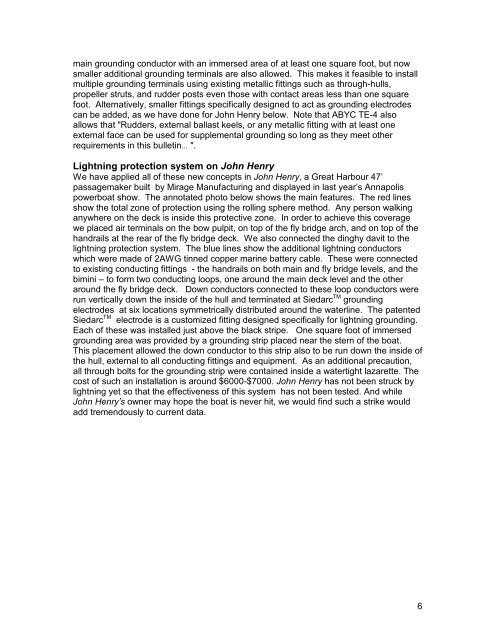A New Concept for Lightning Protection of Boats - Marine Lightning ...
A New Concept for Lightning Protection of Boats - Marine Lightning ...
A New Concept for Lightning Protection of Boats - Marine Lightning ...
Create successful ePaper yourself
Turn your PDF publications into a flip-book with our unique Google optimized e-Paper software.
main grounding conductor with an immersed area <strong>of</strong> at least one square foot, but nowsmaller additional grounding terminals are also allowed. This makes it feasible to installmultiple grounding terminals using existing metallic fittings such as through-hulls,propeller struts, and rudder posts even those with contact areas less than one squarefoot. Alternatively, smaller fittings specifically designed to act as grounding electrodescan be added, as we have done <strong>for</strong> John Henry below. Note that ABYC TE-4 alsoallows that "Rudders, external ballast keels, or any metallic fitting with at least oneexternal face can be used <strong>for</strong> supplemental grounding so long as they meet otherrequirements in this bulletin… ".<strong>Lightning</strong> protection system on John HenryWe have applied all <strong>of</strong> these new concepts in John Henry, a Great Harbour 47’passagemaker built by Mirage Manufacturing and displayed in last year’s Annapolispowerboat show. The annotated photo below shows the main features. The red linesshow the total zone <strong>of</strong> protection using the rolling sphere method. Any person walkinganywhere on the deck is inside this protective zone. In order to achieve this coveragewe placed air terminals on the bow pulpit, on top <strong>of</strong> the fly bridge arch, and on top <strong>of</strong> thehandrails at the rear <strong>of</strong> the fly bridge deck. We also connected the dinghy davit to thelightning protection system. The blue lines show the additional lightning conductorswhich were made <strong>of</strong> 2AWG tinned copper marine battery cable. These were connectedto existing conducting fittings - the handrails on both main and fly bridge levels, and thebimini – to <strong>for</strong>m two conducting loops, one around the main deck level and the otheraround the fly bridge deck. Down conductors connected to these loop conductors wererun vertically down the inside <strong>of</strong> the hull and terminated at Siedarc TM groundingelectrodes at six locations symmetrically distributed around the waterline. The patentedSiedarc TM electrode is a customized fitting designed specifically <strong>for</strong> lightning grounding.Each <strong>of</strong> these was installed just above the black stripe. One square foot <strong>of</strong> immersedgrounding area was provided by a grounding strip placed near the stern <strong>of</strong> the boat.This placement allowed the down conductor to this strip also to be run down the inside <strong>of</strong>the hull, external to all conducting fittings and equipment. As an additional precaution,all through bolts <strong>for</strong> the grounding strip were contained inside a watertight lazarette. Thecost <strong>of</strong> such an installation is around $6000-$7000. John Henry has not been struck bylightning yet so that the effectiveness <strong>of</strong> this system has not been tested. And whileJohn Henry’s owner may hope the boat is never hit, we would find such a strike wouldadd tremendously to current data.6
















